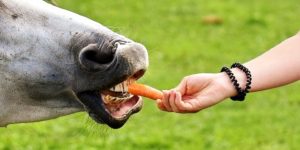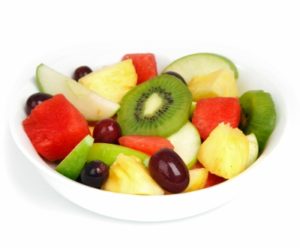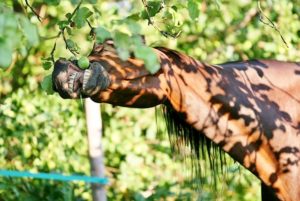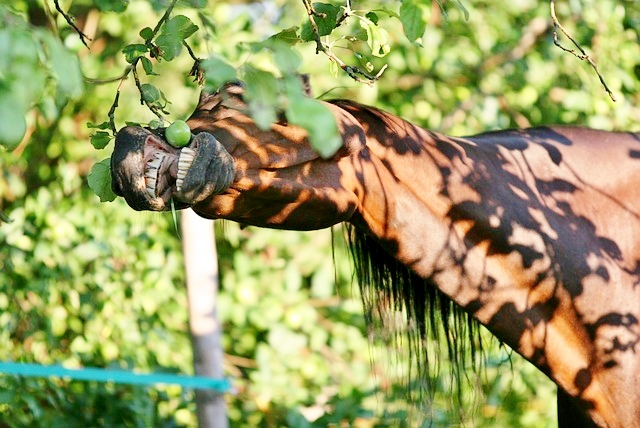By Juliet M. Getty, Ph.D.
 Apples and bananas used to be the predominant fruits available in your grocery store during the fall and winter. But lately, you can find all sorts of off-season fruits, including watermelon and blueberries, thanks to imports from more temperate climates. Your horses can also benefit from this variety. The old standbys – apples and carrots – still make nutritious treats but why limit your horse’s enjoyment to just these?
Apples and bananas used to be the predominant fruits available in your grocery store during the fall and winter. But lately, you can find all sorts of off-season fruits, including watermelon and blueberries, thanks to imports from more temperate climates. Your horses can also benefit from this variety. The old standbys – apples and carrots – still make nutritious treats but why limit your horse’s enjoyment to just these?
Day in and day out, your horse eats the same thing. Boring… yes. Unbalanced… definitely.
It’s not likely that he has acres of unimproved land to explore, as he would in a wild setting, where he would eat flowers, seeds, edible weeds, and fruits from vines and trees. It is our job as horse owners to fortify their ho-hum diets with added nutrients from fresh foods. Sure, there are whole food supplements on the market, really nice ones in fact[i]. But why not add the real thing? Fruit tastes a lot better and is chock full of antioxidants and other valuable nutrients that can have a powerful impact on your horse’s health.
Flavonoids are potent antioxidants
Dark blue and red berries, such as blueberries, blackberries, raspberries, and strawberries as well as cherries and red grapes, contain antioxidants known as epicatechins and anthocyanidins that belong to a group of antioxidants known as flavonoids. Since these flavonoids also give the fruit its color, the deeper the color, the more antioxidant-power the fruit contains. Red grapes also offer resveratrol, an antioxidant that has recently become popular as a horse supplement. (Dark chocolate also contains resveratrol, which is great for you, but never give it to your horse!)
Bananas, surprisingly, are high in anthocyanidins. Citrus fruits such as oranges, grapefruits, lemons and limes, while known for their vitamin C content, also contain considerable amounts of flavonoids such as hesperidin, rutin and quercetin, which work with vitamin C to promote antioxidant activity. Another biologically active flavonoid known as lycopene, adds a red color to watermelon, papaya, and mangos. Important to note: tomatoes are high in lycopene, but are highly toxic to horses.
Beta carotene is a flavonoid that offers an orange color to apricots, papayas, mangos, cantaloupe, nectarines, and peaches, as well as carrots. It is not only a powerful antioxidant, but is a precursor to vitamin A within your horse’s body.
Fruits are also a reliable source of vitamins and minerals. Dried fruits such as figs and dates are particularly concentrated in calcium, zinc, and potassium. They also contain B vitamins, beta carotene, and vitamin K.
Fruits round out the diet beyond traditional supplements
 Concentrated supplements may offer many of the nutrients found in fruits. However, it’s difficult, if not impossible, to gather the entire essence of a plant in a commercial product. By feeding the whole food, you offer your horse trace nutrients that nourish his body in a way that cannot be duplicated by opening a container. It is important to note, however, that filling in the nutritional gaps created by a hay-based diet generally requires concentrated supplements; you would have to feed an unrealistically large amount of fruits and other whole foods to meet this requirement. Fruits should be offered in addition to a balanced diet, to round it out, but not to offer everything your horse needs.
Concentrated supplements may offer many of the nutrients found in fruits. However, it’s difficult, if not impossible, to gather the entire essence of a plant in a commercial product. By feeding the whole food, you offer your horse trace nutrients that nourish his body in a way that cannot be duplicated by opening a container. It is important to note, however, that filling in the nutritional gaps created by a hay-based diet generally requires concentrated supplements; you would have to feed an unrealistically large amount of fruits and other whole foods to meet this requirement. Fruits should be offered in addition to a balanced diet, to round it out, but not to offer everything your horse needs.
Sugar content of common fruits
Fruits do contain a significant amount of sugar. If you have insulin resistant horses, you may be thinking that this article is not for you. While you do need to limit their sugar (and starch) intake, there still can be room for some tasty fresh fruit. The key is moderation, combined with evaluating how much sugar your horse is getting in his entire diet.
Horses love bananas (one of their favorite flavors[ii]). They also like watermelon, cherries, blueberries, and of course, apples. The chart below gives you an idea of how much sugar is in these and other fruits:
|
Sugar Content of Common Fruits[iii]
|
|
| Fruit
|
Grams of sugar |
| Apple, one medium | 13 |
| Apricots, one (no pit!) | 3 |
| Banana, one 7 inch | 14 |
| Blackberries (1 cup) | 7 |
| Blueberries (one cup) | 15 |
| Cantaloupe, 1/8 small melon | 4 |
| Carrot, one 8 inch | 3 |
| Cherries, 6 (no pits) | 6 |
| Dates, three (no pits!) | 12 |
| Figs, one small | 7 |
| Grapes (red, green), 10 grapes | 8 |
| Honeydew melon, 1/8 7” melon | 13 |
| Mango, ½ fruit (without pit) | 15 |
| Nectarines, 1 small (without pit) | 10 |
| Orange, one medium | 15 |
| Papaya, one small (remove seeds) | 9 |
| Peaches, 2 3/4 inches (no pit) | 15 |
| Pears, one medium | 17 |
| Plums, one medium (remove the pit) | 7 |
| Raspberries (1 cup) | 5 |
| Tangerines, 2 1/2 inch | 9 |
| Strawberries, 3 medium | 3 |
| Watermelon, one wedge | 28 |
Some peels are worth eating
A wonderful way to offer your horse something tasty and nutritious is to feed the peel instead of the whole fruit. Apple, banana, and orange peels, as well as watermelon rinds, cut into bite-sized pieces, have less than 1 gram of sugar per cup. Apple peels are particularly beneficial. They contain a substance called “ursolic acid” which has been shown to stimulate muscle growth, increase carbohydrate metabolism, and reduce body fat in laboratory animals.[iv] Avoid the peels of tropical fruits such as mangos and papayas since they can be irritating to the skin.
Putting this into perspective with the rest of the diet
 To reduce the sugar content of your horse’s diet, you should strive to feed less than 10% of the total diet as simple sugars and starch. If you’ve had your hay or pasture analyzed, the ethanol soluble carbohydrate (ESC) value represents the simple sugar content.
To reduce the sugar content of your horse’s diet, you should strive to feed less than 10% of the total diet as simple sugars and starch. If you’ve had your hay or pasture analyzed, the ethanol soluble carbohydrate (ESC) value represents the simple sugar content.
Let’s say your grass hay contains 7.10% ESC and 1.80% starch. Their sum is 8.90% – that’s excellent! This would be a good hay to offer free-choice to your horse.
If your horse consumes 25 lbs per day of this hay, he/she will consume 2.225 lbs of ESC + starch (25 lbs X .0890). Convert that to grams (multiply by 454), providing your horse with 1010.15 grams of sugar and starch. If your horse also eats a cup of blackberries per day, you’ll be providing an additional 7 grams of sugar. This brings the total sugar/starch intake to 1017.15 grams per day, or 8.96% of the diet. Not much of a difference.
One caveat: It is best to divide the amount of fruit you’ll be serving over the course of the day, rather than feeding it all at one time. A large amount of sugar fed at once will create a higher blood glucose peak than if it were fed in smaller amounts throughout the day.
Bottom line
Fruits are bountiful sources of vitamins, minerals, and antioxidants, making them a valuable addition to any horse’s feeding regimen. Diets that need to be low in sugar and starch can still safely accommodate moderate amounts of fresh fruits. This will not only be pleasing to your horse, but will offer additional nutrients that likely do not exist in the current diet.
[i] Whole food supplements can be found at Dr. Getty’s Free Shipping Store, http://horsesupplements.gettyequinenutrition.biz
[ii] Goodwin D., Davidson, H.P. B., Harris, P., 2005. Selection and acceptance of flavours in concentrate diets for stabled horses. Applied Animal Behaviour Science, 95(3-4), 223-232.
[iii] Values obtained from http://nutritiondata.self.com
[iv] Kunkel, S.D., Elmore, C.J., Bongers, K.S., Ebert, S.M, et. al., 2012. Ursolic acid increases skeletal muscle and brown fat and decreases diet-induced obesity, glucose intolerance and fatty liver disease. PLoS ONE 7(6): e39332. https://doi.org/10.1371/journal.pone.0039332
Juliet M. Getty, Ph.D. is an independent equine nutritionist with a wide U.S. and international following. Her research-based approach optimizes equine health by aligning physiology and instincts with correct feeding and nutrition practices. Dr. Getty’s goal is to empower the horseperson with the confidence and knowledge to provide the best nutrition for his or her horse’s needs.
Catch Dr. Getty at her upcoming live Webinar, “Practical Dietary Tips for Promoting Optimal Hoof Health,” sponsored by the American Hoof Association. Sunday September 24, 2017 at 3:00 pm EDT. Register at www.AmericanHoofAssociation.org/events
Dr. Getty’s fundamental resource book, Feed Your Horse Like a Horse, is now in paperback as well as in hardcover, searchable CD and Kindle versions. All except the Kindle version are available at www.GettyEquineNutrition.com — buy the book there and have it inscribed by the author. Print and Kindle versions are also available at Amazon (www.Amazon.com); find print versions at other online retail bookstores. The seven individual volumes in Dr. Getty’s topic-centered “Spotlight on Equine Nutrition” series are available with special package pricing at her website, and also at Amazon in print and Kindle versions. Dr. Getty’s books make ideal gifts for equestrians!
Find a world of useful information for the horseperson at www.GettyEquineNutrition.com: Sign up for Dr. Getty’s informative, free e-newsletter, Forage for Thought; browse her library of reference articles; search her nutrition forum archives; and purchase recordings of her educational teleseminars. Find top-quality supplements, feeders, and other equine-related items, at her online Free Shipping Supplement Store[i]. Reach Dr. Getty directly at gettyequinenutrition@gmail.com.
[i] http://horsesupplements.gettyequinenutrition.biz
Originally Published November 2017 Issue

News from the horse industry. Sharing today’s information as it happens. The Colorado Horse Source is not responsible for the content of 3rd party submissions.

